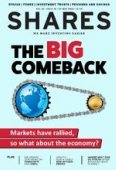Archived article
Please note that tax, investment, pension and ISA rules can change and the information and any views contained in this article may now be inaccurate.
Where next for US shares?

Hard to believe as it may be, America’s S&P 500 index is down by just 3% over the last 12 months, while the NASDAQ Composite is up by 7%.
This seems remarkable, give the COVID-19 outbreak and the economic fallout of the lockdown that is being used to fight it. Surely things cannot be just 3% worse than they were a year ago (when US stocks were already trading close to all-time highs) or 7% better for the tech and biotech stocks which populate the NASDAQ?
But stock markets are forward-looking mechanisms which try to discount, or price in, future events, not backward-looking ones.
Sharp falls amid the panic of February and March tried to factor in the hit to American economic activity and corporate profits and the subsequent rally is now trying to price in the future recovery as several nations, including the US, start to emerge from their lockdowns. The question now is have US stocks gone too far, too fast?
FOR AND AGAINST
The arguments for and against further near-term gains in US equities can be summarised via three topics.
1. Corporate earnings
Case for: US earnings are receiving strong support from leading tech stocks, with the Technology sector forecast to generate 23% of 2020 earnings, according to IBES data from Refinitiv.
That in turn is underpinning consensus analysts’ forecasts that are calling for a V-shaped recovery in corporate earnings, with the Financials, Consumer Discretionary, Industrials and Energy sectors also contributing strongly.
Bottom-up estimates from FactSet suggest US corporate profits will be growing again on a year-on-year basis by Q1 2021 and rise by 21% in 2021 as a whole.
Case against: In six weeks 30m Americans have lost their jobs. Not all of those jobs will come back at all, some may only come back slowly. This could crimp private consumption which drives 70% of US GDP and mean the rebound is much more modest than consensus forecasts suggest.
Additionally, a strong dollar, lockdowns elsewhere and any resumption of trade tensions with China may be unhelpful for exports at the same time. The consensus forecast of a 12% drop in earnings per share for the S&P 500 may not be enough, especially when company profits fell by 31% and 40% during the downturns of 2001 and 2008 respectively.
In addition, the US market is becoming ever-more skewed toward tech stocks. In the past 12 months, the S&P 500 has lost $895bn in market value.
Facebook, Amazon, Apple, Netflix, Google-parent Alphabet and Microsoft have gained $910bn between them. This sextet now represents 20% of the S&P’s value on its own, up from 15% a year ago, so if any of them disappoint with their earnings this could have a disproportionate impact on the index.
2. Fiscal and monetary stimulus
The case for: Even if US GDP were to fall by 10% in 2020, that would roughly equate to a $2trn loss of output. The US government has already signed off a $2.2trn fiscal stimulus programme and the US Federal Reserve, via the resumption of quantitative easing (QE), has already pumped more than $2.5trn of liquidity into the financial system, more than covering that output gap.
That tidal wave of Fed cash may be the most powerful factor of all in the US stock market’s bounce from the 23 March low and the hardest for sceptics of American equities to fight.
The case against: The Fed has begun to throttle back its QE programme, adding ‘just’ $83bn to its asset purchases in the last week for which data is available, compared to the $586bn peak run rate in late March.
Even that easing of stimulus has seen US equities’ recovery lose a little pace. If the rally really is relying on abundant central bank-provided liquidity then that is a brittle set of foundations, as the Fed cannot print forever.
3. Valuation
The case for: The consensus EPS estimates of $174 and $200 for the S&P 500 put the index on 16 times and 14 times earnings for 2020 and 2021 respectively, hardly expensive for a market which is laden with leaders in their chosen industries, notably tech, where a rapid earnings rebound is expected and where the central bank is pouring money into supporting it.
The case against: Those tempting earnings multiples could prove misleading if earnings disappoint. Moreover, the Shiller cyclically-adjusted price earnings ratio (CAPE) still suggests the US equity market is very expensive relative to its history, using inflation-adjusted earnings from the last 10 years as its basis, rather than variable (and dare one say unreliable) earnings forecasts.
The S&P 500 has rarely traded above the current 26-times level using CAPE and when it did, 10-year compound annual returns from the index were negative, as seen after 1929 and 1999.
Important information:
These articles are provided by Shares magazine which is published by AJ Bell Media, a part of AJ Bell. Shares is not written by AJ Bell.
Shares is provided for your general information and use and is not a personal recommendation to invest. It is not intended to be relied upon by you in making or not making any investment decisions. The investments referred to in these articles will not be suitable for all investors. If in doubt please seek appropriate independent financial advice.
Investors acting on the information in these articles do so at their own risk and AJ Bell Media and its staff do not accept liability for losses suffered by investors as a result of their investment decisions.
Issue contents
Editor's View
Feature
First-time Investor
Great Ideas
Money Matters
News
- Exit charge lowered on Lifetime ISA as a temporary measure
- Companies will need to start quantifying Covid-19 impact
- Investors need to be prepared for terrible second quarter results
- Why these stocks have just hit all-time highs
- Orbis seeing ‘most exceptional discounts’ since the credit crunch
- Could we see a return of M&A due to the crisis?
- Berkshire Hathaway builds cash to record levels, sell airline stocks

 magazine
magazine











